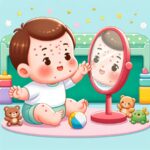Warts are a common skin condition that many children encounter. These small, rough growths can appear anywhere on the body, often causing confusion and concern among new parents. This comprehensive guide aims to shed light on all aspects of warts in children, from their causes and various types to effective treatment options and prevention strategies. Armed with the right knowledge, you can confidently manage this skin condition and ensure your child’s comfort and health.
What are Warts and Why Do Children Get Them?
Warts are caused by the human papillomavirus (HPV), which infects the top layer of the skin. There are over 100 types of HPV, but only a few cause warts on the hands, feet, and other parts of the body. Children are particularly susceptible to warts due to their still-developing immune systems and frequent minor scrapes and cuts, which allow the virus easy entry.
Warts can spread through direct contact with a wart or something that touched a wart, making communal spaces like playgrounds and swimming pools typical hotspots for transmission. Understanding the nature of warts and how they spread is crucial for parents looking to protect their children from this common skin issue.
Types of Warts Commonly Found in Children
There are several types of warts, each appearing on different parts of the body and having a distinct appearance. Common warts typically grow on fingers and toes, plantar warts are found on the soles of the feet, and flat warts can appear on the face, arms, and legs. Each type of wart may require a slightly different approach in terms of treatment and care.
It’s also not uncommon for children to develop multiple warts, given their active and often less hygienic nature. Identifying the type of wart your child has is the first step in seeking appropriate treatment and preventing its spread both to other areas of your child’s body and to other children.
How to Treat Warts in Children
Treatment for warts can vary depending on the type of wart, its location, and the age of the child. Common treatments include salicylic acid preparations, cryotherapy (freezing the wart), and in some cases, laser treatment. It’s important to consult a healthcare professional before starting any treatment to ensure it’s suitable for your child’s specific situation.
Many warts will eventually clear up on their own without treatment, thanks to the body’s immune response. However, because they can be painful, especially plantar warts on the feet, and because they can spread, many parents opt for treatment. For more detailed information on treatment options, the American Academy of Dermatology Association offers great resources.
Preventing Warts in Children
Preventing warts involves a combination of good hygiene practices and minimizing direct contact with warts. Encourage your child to wash their hands regularly, especially after playing outside or in communal areas. Using barrier methods like waterproof sandals in public showers or pools can also help prevent plantar warts.
Additionally, covering warts with bandages can help prevent them from spreading to other parts of the body or to other children. It’s also worth educating your child on the importance of not picking at warts, which can lead to further spread.
For more information on preventing warts and other common childhood conditions, visit our section on water safety and hand-eye coordination, which includes tips on maintaining overall hygiene and health.
When to See a Doctor for Your Child’s Warts
If your child’s warts are causing pain, rapidly multiplying, or not responding to over-the-counter treatments, it’s time to consult a healthcare professional. They can offer more advanced treatments and ensure that the warts are properly diagnosed, especially since other skin conditions can sometimes mimic warts.
Moreover, if your child has a weakened immune system due to other health conditions, professional medical advice is particularly important to prevent complications. Remember, when it comes to your child’s health, it’s always better to err on the side of caution and seek professional guidance.
For further reading on related topics, check out our resources on eczema, skin care, and immunizations, which can provide additional insights into maintaining your child’s skin health and overall well-being.













